Macau Attractions - Things to Do
Top Things to Do
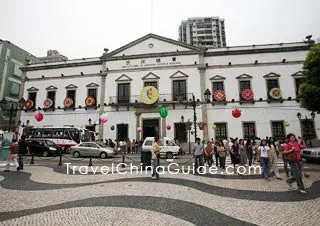 |
| Municipal Council, Senado Square |
![]() Venetian Macau-Resort-Hotel
Venetian Macau-Resort-Hotel ![]() Casino Lisboa
Casino Lisboa![]() Ruins of St. Paul's
Ruins of St. Paul's![]() Senado Square
Senado Square![]() Monte Fort
Monte Fort![]() A-Ma Temple
A-Ma Temple![]() Macau Tower
Macau Tower![]() Fisherman's Wharf
Fisherman's Wharf
Macau has a rich heritage from both its Chinese and Portuguese past that includes many outstanding examples of western and oriental art and culture. Macau points of interest are of many styles, such as Chinese temples, catholic churches; ancient forts and other historical relics within a modern environment that bear testimony to a cultural blend of east and west. Hereunder lists what to do in Macau in different areas:
Macau Peninsula
Macau comprises the Macau Peninsula and the outlying islands of Taipa and Coloane. Popular sightseeing places that form part of a visitor's itinerary are spread all over the Peninsula.
The Central Part
![]() The Historic Centre of Macao
The Historic Centre of Macao![]() Ruins of St. Paul's
Ruins of St. Paul's![]() Monte Fort
Monte Fort![]() The Museum Of Macau
The Museum Of Macau![]() Camoes Garden and Grotto
Camoes Garden and Grotto![]() Senado Square
Senado Square![]() St. Dominic's Church
St. Dominic's Church![]() Cathedral, Macau
Cathedral, Macau![]() Lou Kau Mansion
Lou Kau Mansion![]() Casino Lisboa
Casino Lisboa
Avenida de Almeida Ribeiro, a main downtown thoroughfare in the southwestern part of the city, is called San Ma Lo (New Street) in Chinese by its residents. It stretches from Avenida da Praia Grande to the Inner Harbour, a distance of less than a mile. With the main square, Largo do Senado and several affiliated streets, this area is the most popular shopping and tourist part of the city.
This splendid square, Largo do Senado, with its wave-patterned pavement and central fountain is a highlight of the area. The surrounding simple, elegant Portuguese and baroque style buildings house many international branded clothes shops and restaurants. An exploration of the narrow alleyways that radiate from the square will open up to the visitor yet more fantastic places including curio markets, pharmacies, snack stalls and jewelry shops selling dazzling items.
The Monte Fort, one of the best-preserved forts in Macao can be seen from the main square and the Ruins of St. Paul's, standing close to the Fort, is a local landmark. A walk northward along St. Paul's Street leads to the façade of St. Paul's Church, which was devastated by fire in 1835, with its elegant reliefs that illustrate Bible stories. An underground tomb behind the ruins houses the remains of Catholic martyrs. The Museum of Macau, to the right of the ruins, should not be missed as it has an excellent exhibition of items telling much of the history of the city.
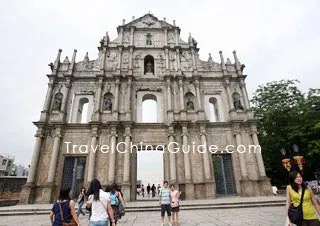 |
| Ruins of St. Paul's Church Facade |
Northwest of the St. Paul's Ruin, is Camoes Garden and Grotto, a memorial garden dedicated to Louis de Camoes, a famous Portuguese poet who lived four hundred years ago. It is a garden residence with a blend of both Chinese and Western architectural styles and has become a popular social meeting place for residents.
The Northern Part
In the eastern part of the city is Guia Hill, the highest point on which is perched Guia Fort and Guia Lighthouse. The Guia Fort built in 1637 is the second largest in the city and the Lighthouse was the first of its kind in the China's coastal area built in 1865. This highland offers a panoramic view of the city and seascapes. A promenade around the hill is an ideal place for relaxation and exercise popular with older residents and leads to Flora Garden. A cable car trail is also available for those who do not wish to walk.
Two blocks southwest of the Flora Garden is a memorial hall dedicated to Dr. Sun Yet-sen. The memorial hall was built by family members of Dr. Sun and the exhibits include a collection of documents, pictures and other historical records of this great man. Proceed a further two blocks to the south and turn right and you will find the entrance to Lou Lim leoc Garden, a famous garden that has been created in the style for which Suzhou is noted.
The Western Part
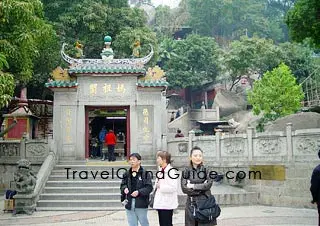 |
| A-Ma Temple |
Starting from Largo do Senado, the heart of downtown, and a walk in a southwesterly direction along the main street brings you to several Catholic churches. Notable among them is St Augustine's, St. Lawrence's, the Chapel of St. Joseph's Seminary and the Headquarters of the Macau SAR. These show much of the Catholic influence on the city. Some churches open to the public.
Situated at the base of Penha Peninsula is A-Ma Temple, built in the Ming Dynasty (1368-1644). The temple is dedicated to the sacred goddess A-Ma, which later was transliterated into 'Macau' by the Portuguese and so became the Portuguese name for Macao. Today this old-time temple is a symbol of the city and devout worshipers visit the temple to pray for good luck. Cross the A-Ma Street, you will reach the Maritime Museum in a building shaped like a boat, where you can learn more about the early days when Portuguese first time set foot here.
Southern Part - Outer Harbor
![]() Fisherman's Wharf
Fisherman's Wharf ![]() Grand Prix Museum
Grand Prix Museum![]() Wine Museum
Wine Museum![]() Museum of Art
Museum of Art![]() Golden Lotus Square
Golden Lotus Square
The southern part of the city near the Outer Harbor is a newly-developed area which is the result of reclamation from the sea. Tourist attractions in this area are devoted to modern things. The Art Museum houses fascinating exhibitions of Chinese traditional calligraphy, paintings, porcelain works and modern art works, the Grand Prix Museum and the Wine Museum are located here as well as the Macau Art Center, where ceremonial concerts and events are held.
The only traditional feature is the 20-meter high Kun Iam Statue, connected by a bridge to the waterfront, opposite the Avenida Dr Sun Yat Sen. The 'lotus seat' is a two storey building housing an exhibition hall and a library dedicated to religious culture and resources with collections of religious books in Chinese, English, Portuguese and other languages.
Outlying Island
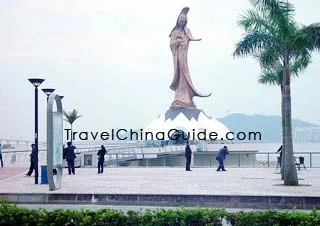 |
| Kwan-yin Statue in New Port Area |
Taipa
Taipa, connected to the Macau Peninsula by the Macau-Taipa Bridge and Friendship Bridge, is where the city's airport is located. The largest casino venue in the city - Jockey Club's horse racing - is the most exciting thing for the local. Five-star hotels offer luxurious amenities and extravagant casinos to gamblers. University of Macau is also located on this island.
A must for travelers is the Taipa Houses Museum. The 'museum' is actually a collection of Portuguese houses featuring both Portuguese and Chinese furniture. It provides tourists with an opportunity to learn about the fashionable lifestyle of Portuguese celebrities. Exhibitions of folk clothing, handcrafts and vicissitude of the Portuguese colonialists are presented here.
Coloane
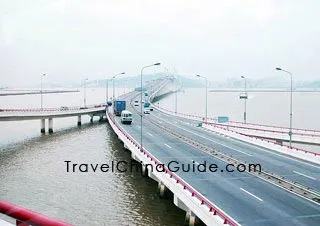 |
| Highway Bridge to Outlying Island |
Tam Kung Miu, a temple dedicated to Tam Kung, a Taoist god of seafarers is situated in the town. A delicately decorated whalebone dragon boat in the temple means it is worthy of a visit. The Museum of Nature & Agriculture has a collection of documents and exhibitions regarding the local fauna and flora as well as the geographical nature of the outlying islands. A collection of agricultural implements and artifacts such as mill wheels and other items used in milling illustrate the methods used by those who in the past were engaged in farming in this region.
What's more, here are other impressive scenic spots which are recommended to you if you have more time to stay in this city. Kun Iam Temple is the most impressive one of the three most famous temples in the city. It is also known as a history witness of the signing of the first Sino-America treaty in 1844. Lin Fung Temple is well-known for the national hero, Lin Zexu who enacted the complete campaign against opium. Sun Yat-Sen Park, one of the forty-three Sun Yat-Sen Parks in the world, was built in 1987 for the friendship between China and Portugal. The Historic Centre of Macao provides a particular proof of the exchange of architecture and religion.
Top 10 Things to Do in Macau
PENSAO ELEGANTE
address : Terreno junto à Calcada de Eugénio Goncalves, Macau Peninsula, Macau, China
i will arrived at 7:00 midnight what is the best transportation to go there thanks
I need help, my son and I will be in HK for the Lunar New Year, and we decide to take a day trip to Macao from Wan Chai, HK. Please guide me with direction how to get to Ferry from HK to Macao and a return to HK. We plan to visit the Ruins of the Church of St Paul, the Kun Iam Statue & A-Ma Temple and Macao Tower in a day. Please let me know bus number for each location. Thank you so much, Amy
To Ruins of the Church of St Paul: take bus 3 to Xinmalu and walk northeast for 5 minutes.
To Statue: take bus 17 straight there.
To A-ma Temple: take bus 10A.
To Macau Tower: take bus 26.
and Venetian Resort Hotel. Can you also include how to go to these places?
Venetian Resort Hotel - Macao Tower - Grand Prix Museum - Senado Square - St Paul Ruins
From the hotel to tower: You may walk to Wangdeshengmuwan Road Bus Stop to take bus no.26A to Yamalaqiandi Bus Stop. Then you may transfer bus no.23 to the tower directly.
From the tower to the museum: You can take bus no.32 at the Tower Bus Stop to Gaomeishi Bus Stop. Upon arrival, you can see the museum directly.
From the museum to Senado Square: You can take bus no.10 at Tourist Activity Center Bus Stop, which is at the gate of the museum to Yinhuangzi Road Bus Stop. When you get off the bus, you may walk 260 meters ahead to the destination.
From Senado Square to St Paul Ruins: You may walk to Maicaodi Street and continue to Dasanba Street to find this scenic spot.